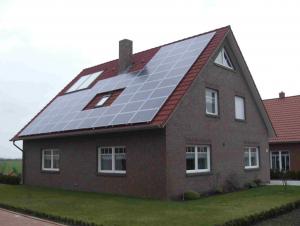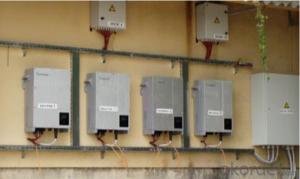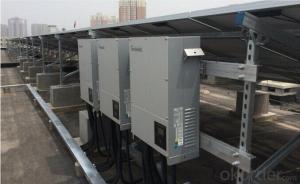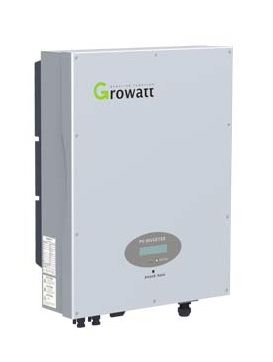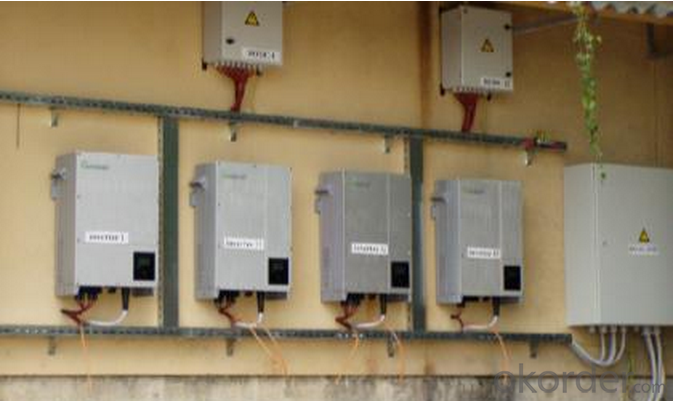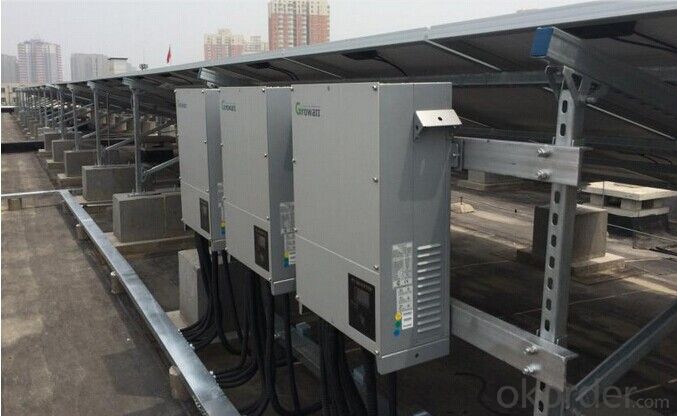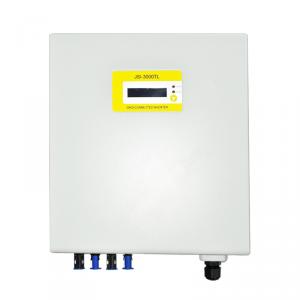Used Grid Connected Solar Inverter 4000-6000UE
- Loading Port:
- Shekou
- Payment Terms:
- TT or LC
- Min Order Qty:
- 10 pc
- Supply Capability:
- 10000 pc/month
OKorder Service Pledge
OKorder Financial Service
You Might Also Like
Grid Connected Solar Inverter 4000-6000UE
Tri-power excellent inverter for small residential and commercial projects
DC input voltage up to 800V
Maximum efficiency of 97.9%
Internal DC switch
Transformerless
Compact design
Multi MPP controller
MTL-string
Bluetooth/ RF technology/ WiFi
Sound control
Easy installation
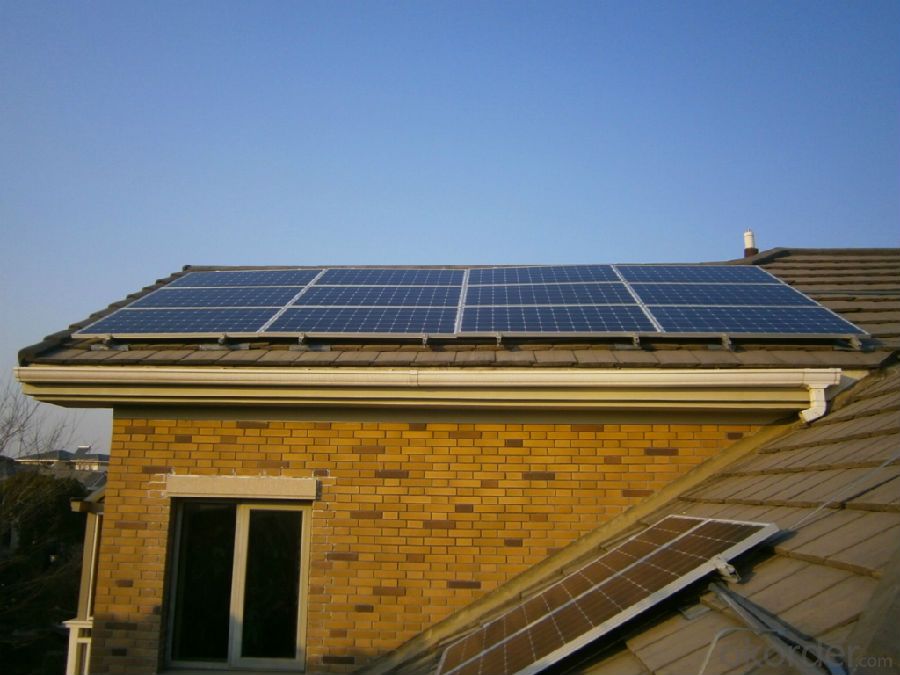
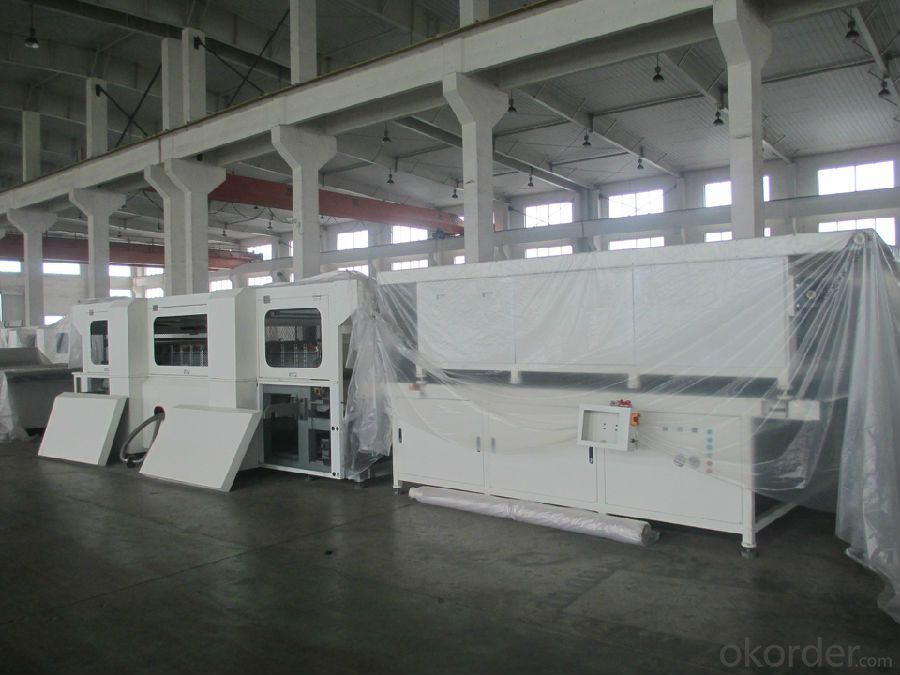
4000UE | 5000UE | 6000UE | |
| Inputdata | |||
| Max.DCpower | 4200W | 5200W | 6300W |
| Max. DC voltage | 800V | 800V | 800V |
| Start Voltage | 150V | 150V | 150V |
| PV voltage range | 140V-800V | 140V-800V | 140V-800V |
| MPP voltage range /Nominal voltage | 200V-800V/ 580V | 200V-800V/ 580V | 200V-800V/ 580V |
| Full load DC voltage range | 250V-750V | 300V-750V | 350V-750V |
| Max. input current / per string | 9A/9A | 9A/9A | 10A/10A |
| Number of independent MPP trackers/strings per MPP tracker | 2/1 | 2/1 | 2/1 |
Output (AC) |
| Rated AC output power | 4000W | 5000W | 6000W |
| Max. AC apparent power | 4000VA | 5000VA | 6000VA |
| Max. output current | 6.4A | 7.9A | 9.3A |
| Max. short-circuit current | 20A | 20A | 20A |
| AC nominal voltage ;range | 230/400V;184-275V | 230/400V;184-275V | 230/400V;184-275V |
| AC grid frequency; range | 50Hz,60Hz; ±5Hz | 50Hz,60Hz; ±5Hz | 50Hz,60Hz; ±5Hz |
| Displacement power factor configurable | 0.9leading-0.9lagging | 0.9leading-0.9lagging | 0.9leading-0.9lagging |
| THDI | <3% | <3% | <3% |
| Grid connection type | 3/N/PE,3W+PE(opt) | 3/N/PE,3W+PE(opt) | 3/N/PE,3W+PE(opt) |
| Efficiency | |||
Max.efficiency | 97% | 97.4% | 97.5% |
| Features | |||
DC connection AC connection Display | H4/MC4(opt) Screw terminal LCD opt/opt/opt | H4/MC4(opt) Screw terminal LCD yes/yes/ opt/opt/opt yes/opt | H4/MC4(opt) Screw terminal LCD yes/yes/ opt/opt/opt yes/opt |
| Generaldata | |||
Dimensions(W/H/D) in mm | 433/566/195 | 433/566/195 31.1KG | 433/566/195 31.1KG |
| Certificates and ApprovalsCE, VDE0126-1-1, VDE-AR-N4105, IEC 62109-1/-2, C-tick, AS/NZS 3100, AS4777, EN61000-6-2 , EN61000-6-3, IEC61727, IEC62116, G83, EN50438 |
- Q: Can a solar inverter be used in regions with high levels of lightning activity?
- Yes, a solar inverter can be used in regions with high levels of lightning activity. However, it is important to ensure that the solar inverter is properly installed and equipped with surge protection devices to mitigate the risks associated with lightning strikes. Additionally, regular maintenance and inspections should be carried out to ensure the safety and functionality of the solar inverter in such regions.
- Q: Can a solar inverter be used with different types of monitoring systems?
- Yes, a solar inverter can be used with different types of monitoring systems. Most modern solar inverters are designed to be compatible with various monitoring systems, allowing users to choose the system that best suits their needs and preferences. This flexibility enables the integration of different monitoring technologies, such as Wi-Fi, Ethernet, or cellular connectivity, making it easier to monitor and manage solar energy production.
- Q: How does a solar inverter handle voltage and frequency variations caused by voltage sags and swells?
- A solar inverter handles voltage and frequency variations caused by voltage sags and swells by monitoring the input voltage and frequency constantly. When it detects a variation, it employs internal control mechanisms to adjust the output voltage and frequency accordingly. This ensures that the solar inverter delivers stable and reliable power to the connected load, even during voltage fluctuations.
- Q: What is the impact of a solar inverter on the overall system cost?
- The impact of a solar inverter on the overall system cost can be significant. A solar inverter is an essential component of a solar power system that converts the direct current (DC) generated by solar panels into alternating current (AC) that can be used to power electrical devices or be fed back into the grid. The cost of a solar inverter can vary depending on its capacity, efficiency, and brand. Generally, more advanced and efficient inverters tend to be more expensive. However, investing in a high-quality inverter can result in long-term savings and improved system performance. One important consideration is the size of the solar power system. Inverters have capacity limits, and selecting an appropriately sized inverter is crucial to optimize energy production and system efficiency. Choosing an undersized inverter can limit the system's performance, while an oversized inverter may result in unnecessary additional costs. The quality and reliability of the inverter are also important factors. A well-built and reliable inverter can minimize maintenance and repair costs, ensuring a longer lifespan for the solar power system. Additionally, advanced features like monitoring capabilities and grid integration functionalities can enhance the overall system performance and provide valuable data for maintenance and troubleshooting, but they may also increase the overall system cost. Moreover, the efficiency of a solar inverter can impact the overall system cost. Higher efficiency inverters can convert a greater amount of DC power into usable AC power, resulting in increased energy production and potentially reducing the number of solar panels required. This can lead to cost savings in terms of panel purchase and installation. In conclusion, while the cost of a solar inverter is an important consideration in overall system cost, it is crucial to balance it with factors such as capacity, efficiency, reliability, and additional features. Investing in a high-quality inverter that is appropriately sized can result in long-term savings, improved system performance, and higher energy production, ultimately maximizing the value and benefits of a solar power system.
- Q: Can a solar inverter be used in areas with high levels of lightning activity?
- Yes, solar inverters can be used in areas with high levels of lightning activity. However, it is important to ensure that the solar inverter is properly grounded and installed with appropriate lightning protection measures to minimize the risk of damage caused by lightning strikes.
- Q: What is the power factor correction capability of a solar inverter?
- The power factor correction capability of a solar inverter refers to its ability to correct any power factor issues in the electrical system it is connected to. A solar inverter typically aims to achieve a power factor as close to 1 as possible, which indicates a balanced and efficient use of electrical power. By actively monitoring and adjusting the power factor, a solar inverter ensures that the energy generated from the solar panels is effectively utilized and does not cause any unnecessary strain on the electrical grid.
- Q: Are all solar inverters compatible with all solar panels?
- No, not all solar inverters are compatible with all solar panels. The compatibility between inverters and panels depends on factors such as voltage, power output, and technology. It is important to ensure that the inverter and solar panels are compatible to optimize the performance and efficiency of the solar energy system.
- Q: What is the role of a power control unit in a solar inverter?
- The role of a power control unit in a solar inverter is to regulate and control the flow of electricity between the solar panels and the grid. It ensures maximum power output from the solar panels by optimizing their performance and matching it with the electrical requirements of the grid. Additionally, it provides protection against overvoltage, overcurrent, and other electrical faults to ensure safe and efficient operation of the solar inverter system.
- Q: How does a solar inverter handle voltage flicker?
- A solar inverter handles voltage flicker by regulating and stabilizing the voltage output. It detects any fluctuations in the grid voltage caused by flicker and adjusts the output accordingly to maintain a consistent and stable voltage for the connected solar panels or other electrical devices.
- Q: What is the role of a power factor controller in a solar inverter?
- The role of a power factor controller in a solar inverter is to regulate and maintain the power factor of the inverter's output. It ensures that the inverter's output power is in phase with the grid voltage, maximizing the efficiency of power transfer and reducing reactive power losses. By improving the power factor, the power factor controller helps to ensure stable and reliable operation of the solar inverter while meeting grid requirements and minimizing energy wastage.
Send your message to us
Used Grid Connected Solar Inverter 4000-6000UE
- Loading Port:
- Shekou
- Payment Terms:
- TT or LC
- Min Order Qty:
- 10 pc
- Supply Capability:
- 10000 pc/month
OKorder Service Pledge
OKorder Financial Service
Similar products
Hot products
Hot Searches
Related keywords


